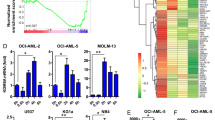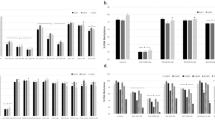Abstract
Histone deacetylase (HDAC) inhibitors either alone or in combination with hypomethylating agents have limited clinical effect in acute myeloid leukemia (AML). Previously, we demonstrated that AML patients with higher miR (microRNA)-29b expression had better response to the hypomethylating agent decitabine. Therefore, an increase in miR-29b expression preceding decitabine treatment may provide a therapeutic advantage. We previously showed that miR-29b expression is suppressed by a repressor complex that includes HDACs. Thus, HDAC inhibition may increase miR-29b expression. We hypothesized that priming AML cells with the novel HDAC inhibitor (HDACI) AR-42 would result in increased response to decitabine treatment via upregulation of miR-29b. Here, we show that AR-42 is a potent HDACI in AML, increasing miR-29b levels and leading to downregulation of known miR-29b targets (that is, SP1, DNMT1, DNMT3A and DNMT3B). We then demonstrated that the sequential administration of AR-42 followed by decitabine resulted in a stronger anti-leukemic activity in vitro and in vivo than decitabine followed by AR-42 or either drug alone. These preclinical results with AR-42 priming before decitabine administration represent a promising, novel treatment approach and a paradigm shift with regard to the combination of epigenetic-targeting compounds in AML, where decitabine has been traditionally given before HDACIs.
This is a preview of subscription content, access via your institution
Access options
Subscribe to this journal
Receive 12 print issues and online access
$259.00 per year
only $21.58 per issue
Buy this article
- Purchase on Springer Link
- Instant access to full article PDF
Prices may be subject to local taxes which are calculated during checkout





Similar content being viewed by others
References
Estey E, Döhner H . Acute myeloid leukaemia. Lancet 2006; 368: 1894–1907.
Estey EH . Treatment of acute myeloid leukemia. Haematologica 2009; 94: 10–16.
Burnett A, Wetzler M, Löwenberg B . Therapeutic advances in acute myeloid leukemia. J Clin Oncol 2011; 29: 487–494.
Bruserud Ø, Stapnes C, Tronstad KJ, Ryningen A, Ånensen N, Gjertsen BT . Protein lysine acetylation in normal and leukaemic haematopoiesis: HDACs as possible therapeutic targets in adult AML. Expert Opin Ther Targets 2006; 10: 51–68.
Tickenbrock L, Klein H-U, Trento C, Hascher A, Göllner S, Bäumer N et al. Increased HDAC1 deposition at hematopoietic promoters in AML and its association with patient survival. Leuk Res 2011; 35: 620–625.
Cashen AF, Schiller GJ, O’Donnell MR, DiPersio JF . Multicenter, phase II study of decitabine for the first-line treatment of older patients with acute myeloid leukemia. J Clin Oncol 2009; 28: 556–561.
Blum W, Garzon R, Klisovic RB, Schwind S, Walker A, Geyer S et al. Clinical response and miR-29b predictive significance in older AML patients treated with a 10-day schedule of decitabine. Proc Natl Acad Sci USA 2010; 107: 7473–7478.
Byrd JC, Marcucci G, Parthun MR, Xiao JJ, Klisovic RB, Moran M et al. A phase 1 and pharmacodynamic study of depsipeptide (FK228) in chronic lymphocytic leukemia and acute myeloid leukemia. Blood 2005; 105: 959–967.
Garcia-Manero G, Kantarjian HM, Sanchez-Gonzalez B, Yang H, Rosner G, Versotovsek S et al. Phase 1/2 study of the combination of 5-aza-2′-deoxycytidine with valproic acid in patients with leukemia. Blood 2006; 108: 3271–3279.
Garcia-Manero G, Yang H, Bueso-Ramos C, Ferrajoli A, Cortes J, Wierda WG et al. Phase 1 study of the histone deacetylase inhibitor vorinostat (suberoylanilide hydroxamic acid [SAHA]) in patients with advanced leukemias and myelodysplastic syndromes. Blood 2008; 111: 1060–1066.
Blum W, Klisovic RB, Hackanson B, Liu Z, Liu S, Devine H et al. Phase I study of decitabine alone or in combination with valproic acid in acute myeloid leukemia. J Clin Oncol 2007; 25: 3884–3891.
Furumai R, Komatsu Y, Nishino N, Khochbin S, Yoshida M, Horinouchi S . Potent histone deacetylase inhibitors built from trichostatin A and cyclic tetrapeptide antibiotics including trapoxin. Proc Natl Acad Sci USA 2001; 98: 87–92.
Krämer OH, Zhu P, Ostendorff HP, Golebiewski M, Tiefenbach J, Peters MA et al. The histone deacetylase inhibitor valproic acid selectively induces proteasomal degradation of HDAC2. EMBO J 2003; 22: 3411–3420.
Lu Q, Yang Y-T, Chen C-S, Davis M, Byrd JC, Etherton MR et al. Zn2+-chelating motif-tethered short-chain fatty acids as a novel class of histone deacetylase inhibitors. J Med Chem 2004; 47: 467–474.
Lucas DM, Alinari L, West DA, Davis ME, Edwards RB, Johnson AJ et al. The novel deacetylase inhibitor AR-42 demonstrates pre-clinical activity in B-cell malignancies in vitro and in vivo. PLoS One 2010; 5: e10941.
Zhang S, Suvannasankha A, Crean CD, White VL, Chen C-S, Farag SS . The novel histone deacetylase inhibitor, AR-42, inhibits gp130/Stat3 pathway and induces apoptosis and cell cycle arrest in multiple myeloma cells. Int J Cancer 2011; 129: 204–213.
Zimmerman B, Sargeant A, Landes K, Fernandez SA, Chen C-S, Lairmore MD . Efficacy of novel histone deacetylase inhibitor, AR-42, in a mouse model of, human T-lymphotropic virus type 1 adult T cell lymphoma. Leuk Res 2011; 35: 1491–1497.
Wang Y, Li Z, He C, Wang D, Yuan X, Chen J et al. MicroRNAs expression signatures are associated with lineage and survival in acute leukemias. Blood Cells Mol Dis 2010; 44: 191–197.
Marcucci G, Mrózek K, Radmacher MD, Garzon R, Bloomfield CD . The prognostic and functional role of microRNAs in acute myeloid leukemia. Blood 2011; 117: 1121–1129.
Garzon R, Heaphy CEA, Havelange V, Fabbri M, Volinia S, Tsao T et al. MicroRNA 29b functions in acute myeloid leukemia. Blood 2009; 114: 5331–5341.
Garzon R, Liu S, Fabbri M, Liu Z, Heaphy CEA, Callegari E et al. MicroRNA-29b induces global DNA hypomethylation and tumor suppressor gene reexpression in acute myeloid leukemia by targeting directly DNMT3A and 3B and indirectly DNMT1. Blood 2009; 113: 6411–6418.
Liu S, Wu L-C, Pang J, Santhanam R, Schwind S, Wu Y-Z et al. Sp1/NFκB/HDAC/miR-29b regulatory network in KIT-driven myeloid leukemia. Cancer Cell 2010; 17: 333–347.
Park JH, Jung Y, Kim TY, Kim SG, Jong HS, Lee JW et al. Class I histone deacetylase-selective novel synthetic inhibitors potently inhibit human tumor proliferation. Clin Cancer Res 2004; 10: 5271–5281.
Stapnes C, Ryningen A, Hatfield K, Øyan AM, Eide GE, Corbascio M et al. Functional characteristics and gene expression profiles of primary acute myeloid leukaemia cells identify patient subgroups that differ in susceptibility to histone deacetylase inhibitors. Int J Oncol 2007; 31: 1529–1538.
Sampath D, Liu C, Vasan K, Sulda M, Puduvalli VK, Wierda WG et al. Histone deacetylases mediate the silencing of miR-15a, miR-16, and miR-29b in chronic lymphocytic leukemia. Blood 2011; 119: 1162–1172.
Kulp SK, Chen CS, Wang DS, Chen CY, Chen CS . Antitumor effects of a novel phenylbutyrate-based histone deacetylase inhibitor, (S)-HDAC-42, in prostate cancer. Clin Cancer Res 2006; 12: 5199–5206.
Bruserud Ø, Stapnes C, Ersvaer E, Gjertsen BT, Ryningen A . Histone deacetylase inhibitors in cancer treatment: a review of the clinical toxicity and the modulation of gene expression in cancer cell. Curr Pharm Biotechnol 2007; 8: 388–400.
Lane AA, Chabner BA . Histone deacetylase inhibitors in cancer therapy. J Clin Oncol 2009; 27: 5459–5468.
Bruserud Ø, Gjertsen BT, Foss B, Huang TS . New strategies in the treatment of acute myelogenous leukemia (AML): in vitro culture of aml cells—the present use in experimental studies and the possible importance for future therapeutic approaches. Stem Cells 2001; 19: 1–11.
Xiong Y, Dowdy SC, Podratz KC, Jin F, Attewell JR, Eberhardt NL et al. Histone deacetylase inhibitors decrease DNA methyltransferase-3B messenger RNA stability and down-regulate de novo DNA methyltransferase activity in human endometrial cells. Cancer Res 2005; 65: 2684–2689.
Zhou Q, Agoston AT, Atadja P, Nelson WG, Davidson NE . Inhibition of histone deacetylases promotes ubiquitin-dependent proteasomal degradation of DNA methyltransferase 1 in human breast cancer cells. Mol Cancer Res 2008; 6: 873–883.
Kalac M, Scotto L, Marchi E, Amenqual J, Seshan VE, Bhagat G et al. HDAC inhibitors and decitabine are highly synergistic and associated with unique gene-expression and epigenetic profiles in models of DLBCL. Blood 2011; 118: 5506–5516.
Richon VM, Sandhoff TW, Rifkind RA, Marks PA . Histone deacetylase inhibitor selectively induces p21WAF1 expression and gene-associated histone acetylation. Proc Natl Acad Sci USA 2000; 97: 10014–10019.
Leone G, D’Aló F, Zardo G, Voso MT, Nervi C . Epigenetic treatment of myelodysplastic syndromes and acute myeloid leukemias. Curr Med Chem 2008; 15: 1274–1287.
Kirschbaum M, Gojo I, Goldberg SL, Kujawski L, Atallah E, Marks P et al. Vorinostat in combination with decitabine for the treatment of relapsed or newly diagnosed AML (AML) or myelodysplastic syndrome (MDS): a phase I, dose-escalation study. Blood 2009; 114: 2089.
Yang H, Fang Z, Wei Y, Hu Y, Calin GA, Kantarjian HM et al. Levels of miR-29b do not predict for response in patients with acute myelogenous leukemia treated with the combination of 5-azacytidine, valproic acid, and ATRA. Am J Hematol 2011; 86: 237–238.
Aimiuwu J, Wang H, Chen P, Xie Z, Wang J, Liu S et al. RNA-dependent inhibition of ribonucleotide reductase is a major pathway for 5-azacytidine activity in acute myeloid leukemia. Blood 2012; 119: 5229–5238.
Metzeler KH, Walker A, Geyer S, Garzon R, Klisovic RB, Bloomfield CD et al. DNMT3A mutations and response to the hypomethylating agent decitabine in acute myeloid leukemia. Leukemia 2012; 26: 1106–1107.
Blum W, Schwind S, Tarighat SS, Geyer S, Eisfeld AK, Whitman S et al. Clinical and pharmacodynamic activity of bortezomib and decitabine in acute myeloid leukemia. Blood 2012; 119: 6025–6031.
Acknowledgements
Supported in part by CA158350, CA102031, CA140158, The Coleman Leukemia Research Foundation (SS), The Harry Mangurian foundation, NIH T32 grant 60032104 (AM), K12CA133250 (AW). AW is a Paul Calabresi Clinical Scholar and a scholar of the American Society of Hematology-Amos Medical Faculty Development Program. We thank Donna Bucci and the Leukemia Tissue Bank for assistance with the primary AML samples. We would like to thank Samuel Kulp, DVM, PhD for assistance with AR-42.
Author information
Authors and Affiliations
Corresponding author
Ethics declarations
Competing interests
The authors declare no conflict of interest.
Additional information
Presented in part at the 103rd Annual Meeting of the American Association for Cancer Research, Chicago, IL, April 2012, and published in abstract form.
Author contributions
AM, JS, RS, AD, CW, PH, XH, ST and SS performed experiments. AM, HW, XH, KKC, DP, CSC, RG, SS and GM designed experiments and analyzed data. AM, AW, LJL, SJ, KM, CDB, SS and GM wrote the manuscript. All the authors approved the manuscript. AW, RBK, RG, WB, MC, JCB and GM were involved directly or indirectly in care of patients or sample procurement.
Supplementary Information accompanies the paper on the Leukemia website
Supplementary information
Rights and permissions
About this article
Cite this article
Mims, A., Walker, A., Huang, X. et al. Increased anti-leukemic activity of decitabine via AR-42-induced upregulation of miR-29b: a novel epigenetic-targeting approach in acute myeloid leukemia. Leukemia 27, 871–878 (2013). https://doi.org/10.1038/leu.2012.342
Received:
Revised:
Accepted:
Published:
Issue Date:
DOI: https://doi.org/10.1038/leu.2012.342
Keywords
This article is cited by
-
The role of miRNA-29b1, MMP-2, MMP-9 mRNAs, and proteins in early diagnosis of HCC
Egyptian Journal of Medical Human Genetics (2023)
-
A phase 1 trial of the histone deacetylase inhibitor AR-42 in patients with neurofibromatosis type 2-associated tumors and advanced solid malignancies
Cancer Chemotherapy and Pharmacology (2021)
-
Hypomethylating Agents as a Therapy for AML
Current Hematologic Malignancy Reports (2017)
-
Determination of AR-42 enantiomeric purity by HPLC on chiral stationary phase
Journal of the Iranian Chemical Society (2017)
-
The dual epigenetic role of PRMT5 in acute myeloid leukemia: gene activation and repression via histone arginine methylation
Leukemia (2016)



